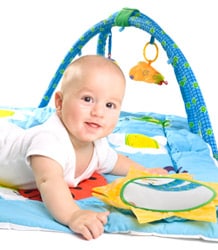Living with Spina Bifida: Infants

Having a new baby is an exciting and challenging time. New parents often feel many different emotions―such as love, joy, happiness, worry, and exhaustion. The same is true for parents who have a child affected by spina bifida. However, in addition to adjusting to life with a new baby, parents of a child with spina bifida also need to learn as much as possible about the condition to prepare for the needs of their child.
Learning about Spina Bifida
When parents find out they are going to have a child with spina bifida, it can be overwhelming. It’s important that they know that most children born with spina bifida reach their full potential.
It is very important for parents to take an active role in managing their child’s care. Parents need to know about spina bifida and understand the health issues and treatment options to make the best possible choices for the health and happiness of their child.
- Parents should talk with a health care provider about any questions or concerns they have.
- Parents can start learning about spina bifida by reading CDC’s Facts and Health Issues and Treatments spina bifida pages.
- The Spina Bifida Association provides information on spina bifida and can be helpful in recommending clinics with health care providers who are experts in the care of children and adults with spina bifida.
Physical Health―What to Expect
No two babies with spina bifida are exactly alike. Each child will have evolution in his/her condition with growth and development. Some babies have issues that are more severe than other babies.
Open Spina Bifida
When a baby is born with open spina bifida, in which the spinal cord is exposed (myelomeningocele), doctors will perform surgery to close it before birth or within the first few days of the baby’s life.
Hydrocephalus
Many babies born with spina bifida get hydrocephalus (often called water on the brain), which is caused by the brain fluid (cerebrospinal fluid) not appropriately draining through the natural channels in the brain and spinal cord. This means that there is extra fluid in and around the brain. The extra fluid can cause the spaces in the brain, called ventricles, to become too large and the head can swell. Hydrocephalus needs to be followed closely and treated properly to prevent brain injury.
If a baby with spina bifida has hydrocephalus, a neurosurgeon can put in a shunt. A shunt is a small hollow tube that will help drain the fluid from the baby’s brain and protect it from too much pressure. Additional surgery might be needed to change the shunt as the child grows up or if it becomes clogged or infected.
For more information, please visit the Spina Bifida Association website:
Hydrocephalus and Shunts

Mobility and Physical Activity
People affected by spina bifida get around in different ways. These include walking without any aids or assistance; walking with braces, crutches or walkers; and using wheelchairs.
People with spina bifida higher on the spine (near the head) might have paralyzed legs and use wheelchairs. Those with spina bifida lower on the spine (near the hips) might have more use of their legs and use crutches, braces, or walkers, or they might be able to walk without these devices.
Doctors can start treatment for movement problems soon after a baby with spina bifida is born. A physical therapist can work with parents and caregivers to teach them how to exercise a baby’s legs to increase strength, flexibility, and movement. Specialized orthotics technologists can fit a baby or young child with braces to help the legs develop without curvature and support the child as he/she begins to crawl and walk.
Regular physical activity is important for all babies, especially for those with conditions that affect movement, such as spina bifida. There are many ways for babies with spina bifida to be active. For example, they can:
- Play with toys, such as activity mats.
- Enjoy parks and recreation areas.
- Participate in community programs, such as the Early Intervention Program for Infants and Toddlers with Disabilities, which is a free program in many communities.
- Do exercises recommended by a physical therapist.
For more information, please visit the following websites:
Early Intervention Programs for Infants and Toddlers
Skin
Babies with spina bifida can develop sores, calluses, blisters, and burns on their feet, ankles, and hips. Many cannot feel their skin below the level of their spina bifida. Because of this, babies will not feel and react to pain in that part of their body. Parents and caregivers can help protect the baby’s skin by:
- Checking the baby’s skin every day for redness, including under braces.
- Trying to avoid hot bath water, hot irons and hot or unpadded seatbelt clasps that may cause burns.
- Making sure the baby doesn’t stay out in the sun too long.
- Making sure the baby is not sitting or lying in one position for too long.
Did You Look? Healthy Skin Starts With You!
Latex (Natural Rubber) Allergy
Many babies with spina bifida can develop sensitivity to products that contain latex, or natural rubber. This means they should not use items made of natural rubber (“latex”). For babies, this would include rubber nipples and pacifiers. The baby can wear a bracelet to alert other people of the allergy. Parents and caregivers should discuss this with their baby’s health care providers.
For more information, please visit the Spina Bifida Association website:
Latex (Natural Rubber) Allergy in Spina Bifida
Health Checks
Every baby needs a primary health care provider (for example, a pediatrician, family doctor, or nurse practitioner). The primary health care provider will want to make sure that the baby is healthy; developing normally; and receiving immunization against diseases and infections, including the flu.
In addition to seeing a primary health care provider, shortly after birth the baby will be checked and treated as needed by doctors who specialize in different parts of the body that are impacted by spina bifida.
These specialists might include:
- An orthopedist, who will work with the baby’s muscles and bones.
- A urologist, who will check the baby’s kidneys and bladder.
- A neurosurgeon, who will check the baby’s brain and spine.
Finding Support
Having support and community resources can help increase confidence in managing spina bifida, enhance quality of life, and assist in meeting the needs of all family members. Regional chapters of the Spina Bifida Association and Spina Bifida Coalition can be found by asking providers or searching on the web. Often, other parents of children with special needs can give advice about good resources for these children. Remember that the choices of one family might not be best for another family, so it’s important that parents understand all options and discuss them with their child’s health care providers.
- A Spina Bifida Association (SBA) Chapter is a great place to connect with other families. The SBA website can provide information on how to find a local chapter.
- Connect online with others.
- National Resource Center Get information and find clinics or health care providers who are experts on spina bifida.
References
Sandler, Adrian, M.D.(2004). Living with Spina Bifida: A Guide for Families and Professionals. University of North Carolina Press: Chapel Hill.
Spina Bifida Association. Guidelines for the Care of People with Spina Bifida. 2018. http://www.spinabifidaassociation.org/guidelines/